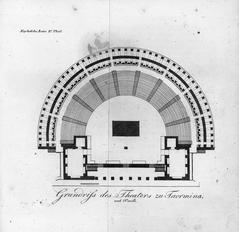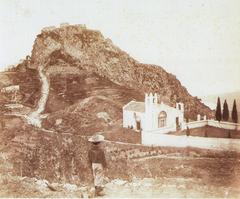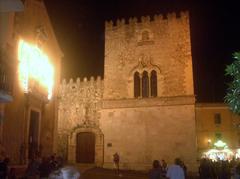Chianchitta-Trappitello Visiting Hours, Tickets, and Taormina Historical Sites Guide
Date: 04/07/2025
Introduction to Chianchitta-Trappitello and Its Historical Significance
Nestled in the lush Alcantara Valley, Chianchitta-Trappitello is a vibrant district that serves as a gateway to Taormina, one of Sicily’s most celebrated towns. This unique locality combines a rich agricultural heritage, authentic Sicilian lifestyle, and strategic access to some of the island’s most remarkable historical and natural sites. Its history, shaped by Greek, Roman, Byzantine, Arab, Norman, and Spanish influences, traces back to the 4th century BC and the founding of Tauromenion. Today, Chianchitta-Trappitello offers visitors both a window into Sicily’s layered past and the warmth of a living community.
This detailed guide provides essential information on visiting hours, tickets, transportation, accommodations, and dining, as well as an in-depth look into Chianchitta-Trappitello’s role within the broader Taormina region. Whether you’re interested in exploring ancient ruins, scenic landscapes, or traditional Sicilian festivities like the “Presepe Vivente di Trappitello,” this resource is designed to help you plan a memorable and well-informed visit.
For more historical background and visitor tips, see Exploring Chianchitta-Trappitello: Visiting Hours, Tickets, and Historical Sites Near Taormina and Practical Visitor Tips for Chianchitta-Trappitello.
Table of Contents
- Introduction
- Ancient Roots and the Birth of Taormina
- Roman and Byzantine Influence
- Medieval Expansion and the Rise of Outlying Villages
- Modern Era: From Rural Outpost to Gateway
- Visiting Hours and Tickets for Key Taormina Historical Sites
- Accessibility and Travel Tips
- Accommodation and Dining Recommendations
- Notable Historical Sites and Landmarks Near Chianchitta-Trappitello
- Demographic and Administrative Context
- Cultural Continuity and Modern Life
- FAQ
- Visuals and Media
- Conclusion and Call to Action
Ancient Roots and the Birth of Taormina
The history of Chianchitta-Trappitello is closely intertwined with that of Taormina. The ancient city of Tauromenion was founded in the 4th century BC by the Siculi and Greek settlers who relocated after the destruction of Naxos. Perched strategically on Mount Taurus overlooking the Ionian Sea and the fertile Alcantara Valley, Taormina quickly became an important urban center, influencing the surrounding agricultural zones—including what is now Chianchitta-Trappitello (Italy This Way; Wikipedia).
Roman and Byzantine Influence
By the 3rd century BC, Taormina had become part of the Roman Empire, enjoying the privileges of a federated city. The fertile lands of the Alcantara Valley, including Chianchitta-Trappitello, were integral to supplying the city with agricultural products such as grains, olives, and wine (Italy This Way). Subsequent Byzantine and Arab periods saw further development of agricultural techniques, notably advanced irrigation introduced by the Arabs, which increased productivity and shaped the local landscape.
Medieval Expansion and the Rise of Outlying Villages
The Norman conquest in the 11th century initiated a period of rebuilding and expansion. Outlying areas, including Chianchitta and Trappitello, began forming as rural hamlets supporting Taormina. Under Spanish rule, the construction of villas and farmsteads increased, and the district’s agricultural output—particularly citrus and vines—became central to the region’s economy (Italy This Way).
Modern Era: From Rural Outpost to Gateway
The 19th and 20th centuries brought significant infrastructure improvements, including roads and railways linking Taormina and its hinterlands (Wikipedia; Mapcarta). Chianchitta-Trappitello transformed into a residential and commercial hub, benefiting from its proximity to key transport routes and the rise of mass tourism in Taormina. The area now offers easier access to both Taormina’s historic center and natural attractions such as the Alcantara Gorge.
Visiting Hours and Tickets for Key Taormina Historical Sites
Ancient Greek Theatre of Taormina
- Hours: Daily, 9:00 AM–7:00 PM (last entry 6:30 PM)
- Tickets: ~€10 adults; discounts for EU citizens under 25; free for children under 18. Purchase online or at entrance.
Isola Bella Nature Reserve
- Open year-round, 8:00 AM to sunset. Some areas may require a small fee for guided tours.
Alcantara Gorge
- Hours: Daily, 9:00 AM–6:00 PM. Entrance ~€5. Access may be limited during inclement weather. Guided hikes and boat trips available.
Always check official sites or tourist offices for up-to-date hours and ticket information, especially during festivals or holidays.
Accessibility and Travel Tips
Chianchitta-Trappitello is easily accessible by car, bus, or train from Catania, Messina, and Taormina. The Taormina–Giardini railway station and local bus routes provide efficient connections. Walking paths link the area with Taormina’s center, though some routes may be steep.
Best visiting seasons:
- Spring (April–June) and fall (September–October) offer pleasant weather and fewer crowds.
- Summer is lively but can be hot and busy.
Wear comfortable shoes for exploring archaeological sites and bring water, especially in summer.
Accommodation and Dining Recommendations
Accommodations range from budget guesthouses and B&Bs to boutique hotels and vacation rentals, often at more affordable rates than Taormina’s center (Rachel IRL). Book early for peak summer months.
Dining options include traditional trattorias, pizzerias, and bakeries. Enjoy local specialties such as fresh seafood, citrus-based dishes, and regional wines. Weekly markets provide opportunities to sample and purchase Sicilian produce.
Notable Historical Sites and Landmarks Near Chianchitta-Trappitello
- Ancient Greek Theatre of Taormina: Iconic Hellenistic amphitheater with views of Mount Etna (Italy Expert).
- Corso Umberto: Main pedestrian street with shops, cafes, and historic architecture.
- Isola Bella: Scenic island nature reserve, accessible by a narrow isthmus.
- Alcantara Gorge: Dramatic lava-formed canyon ideal for hiking and swimming.
Demographic and Administrative Context
Chianchitta-Trappitello is administratively part of Taormina, benefitting from shared municipal services and infrastructure. Its population has grown steadily due to its strategic role as both a residential and tourism hub (Tuttitalia).
Cultural Continuity and Modern Life
The district maintains traditional Sicilian culture through year-round festivals, religious events, and culinary traditions. The annual “Presepe Vivente di Trappitello” living nativity scene draws visitors and highlights the community’s hospitality (Vai Taormina). Local markets, bakeries, and trattorias offer a blend of old-world charm and modern comfort.
Frequently Asked Questions (FAQ)
Q: What are the visiting hours for the Ancient Greek Theatre of Taormina?
A: 9:00 AM–7:00 PM daily, last entry 6:30 PM.
Q: How do I get to Chianchitta-Trappitello from Taormina?
A: By local bus, taxi, or walking routes. Train and bus stations are nearby.
Q: Are guided tours available?
A: Yes, for major sites and cultural experiences.
Q: Where can I buy tickets for Taormina historical sites?
A: Online or at site entrances.
Q: When is the best time to visit?
A: Spring and fall for mild weather and smaller crowds.
Visuals and Media
[Insert high-quality images:
- Olive groves with Mount Etna in the background
- Panoramic view of Chianchitta-Trappitello
- Ancient Greek Theatre with sea and volcano backdrop
- Presepe Vivente di Trappitello festival scenes]
Descriptive alt text example: “Chianchitta-Trappitello olive groves and Mount Etna.”
Conclusion and Call to Action
Chianchitta-Trappitello is an inviting and authentic Sicilian district that complements Taormina’s historic appeal. With its strategic location, deep-rooted traditions, and easy access to major sites, it is ideal for travelers seeking both cultural immersion and convenience. Plan your visit today, book tickets in advance, and make the most of your experience with local insights.
For more guides, travel tips, and exclusive offers, download the Audiala app and follow us on social media for the latest updates.
References and Further Reading
- Exploring Chianchitta-Trappitello: Visiting Hours, Tickets, and Historical Sites Near Taormina, Italy This Way
- Chianchitta-Trappitello Guide, Terre da Mare
- Practical Visitor Tips for Chianchitta-Trappitello, Wandering Italy
- Complete Guide to Visiting Taormina’s Historical Sites, Official Taormina Tourism
- Presepe Vivente di Trappitello 2024–2025, Vai Taormina
- Mapcarta: Taormina–Giardini Railway Station
- Wikipedia: History of Taormina



